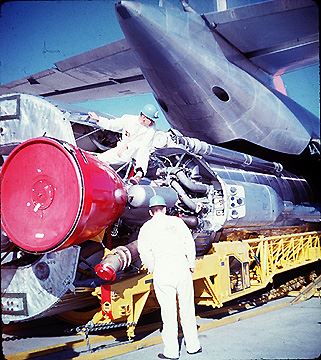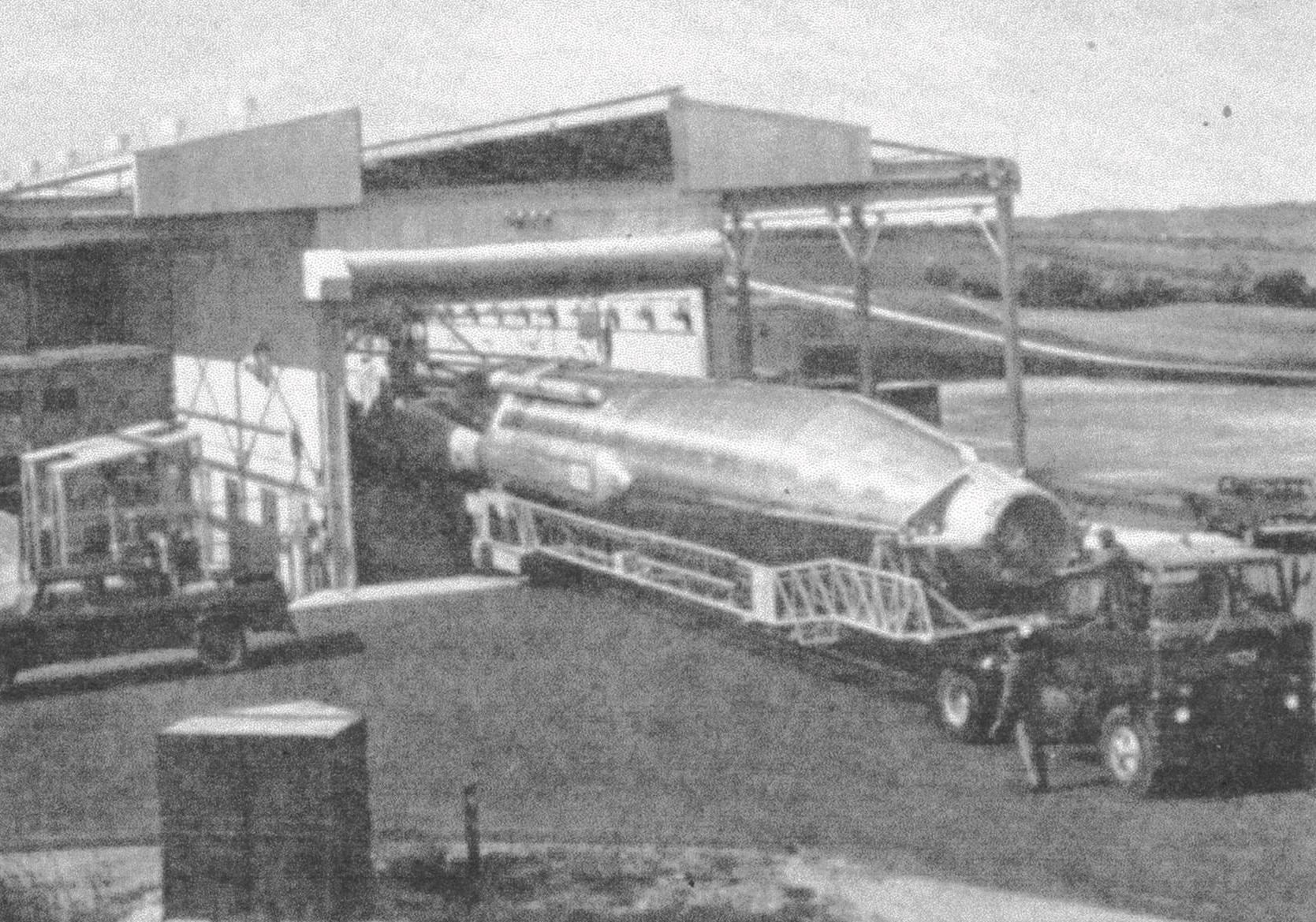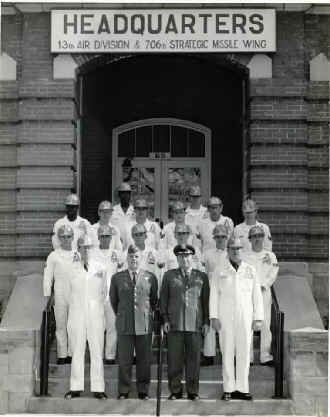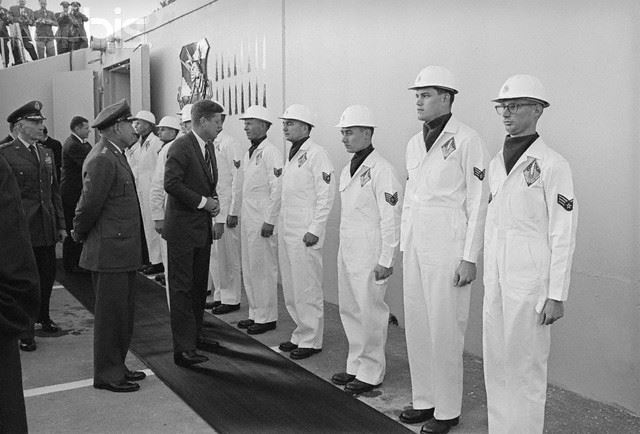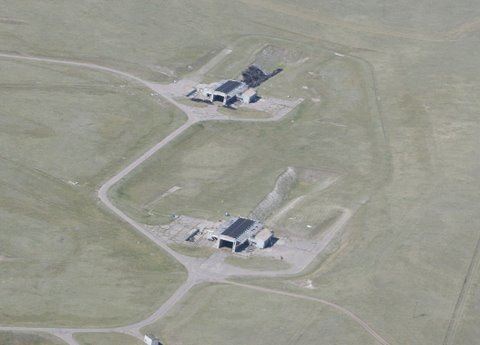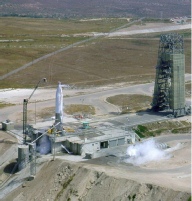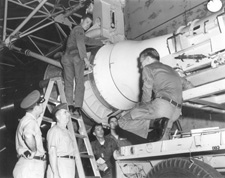Atlas D ICBM (SM-65D, CGM-16D)
Deployed in soft, above ground horizontal “coffins” with three missiles and one control center per complex and in three above ground gantries at Vandenberg AFB. Guided by a ground-based radio-inertial system. Missiles in coffins on alert horizontal, raised to vertical position by the erector before launch, then filled with liquid oxygen (LOX) and RP-1 propellant, and launched. Photos - Right, loading an Atlas into a C-133. Below, preparing to install an Atlas D. |
|
| Atlas D Units 576th Strategic Missile Squadron (SMS), Vandenberg AFB, California - one soft, above site with three gantries and one site with three coffins. Activated April 1958, Closed April 1966, later reactivated and now the 576th Flight Test Squadron at Vandenberg. 564th SMS, FE Warren AFB, Wyoming - two sites, each with three coffins. Activated September 1958, closed September 1964. 565th SMS, FE Warren AFB, Wyoming - three sites, each with three coffins. Activated December 1958, closed December 1964. 549th SMS, Offutt AFB, Nebraska - three sites, each with three coffins. Activated August 1959, closed December 1964. The 564th and 564th SMS were part of the 706/389th Strategic Missile Wing. The 564th SMS was orginally designated the 549th SMS - the two units switched designations on 1 July 1959. |
Atlas D Combat Crews Crew for the gantry launched version was considerably larger than that for the crew at the operational coffin sites. Crews included two officers, the launch officer and the guidance officer, and enlisted missile maintenance, ballistic missile analyst, guidance and power production technicians. Crews were on alert for 24 hours, with a new crew departing the main base each morning to replace the crew on duty. Standard crew uniform was the one piece white coveralls, although olive drab fatigues were sometimes worn, as well as dress blues. Officers often wore dress uniforms. Maintenance The Offutt squadron was a free standing units assigned to a bomb wing at the host base. Most maintenance was internal, part of the Chief of Maintenance part of the squadron, which included specialists in all aspects required to maintain the missile, the site, the electronics and the reentry vehicle. There were several hundred members of each squadron, with about 16 combat crews and a significant number of missile maintenance, missile facility, power production, missile electronics and other enlisted technicians in the unit. In most cases, the propellant technicians, nuclear weapons technicians and real property installed equipment technicians were part of the host bomb wing. The Warren squadrons were part of the 389th Strategic Missile Wing, with all maintenance part of the wing.. Atlas D CountdownFrom execution to launch was about 15 minutes for the first missile at an Atlas D complex. The crew began by opening the roof of the coffin, erecting each missile to vertical and loading RP-1 and LOX one each missile, locked the radio guidance on the first missile to be launched, guiding it thfought the powered flight phase and then repeating for the second and third missiles. the second and third launched at about 22 and 30 minutes after execution. Photos to Right - First Warren crew to launch an Atlas D on the steps of the headquarters. Warren crew meets President Kennedy at Vandenberg after launch in 1962 |
|
Maintenance: Missile Combat Crews performed daily inspections and participated in some maintenance procedures, but the majority of maintenance actions, from installing the missile and reentry vehicle to repairing or replacing faulty equipment or systems involved maintenance specialists from the maintenance squadrons in the 389 SMW at Warren or the maintenance part of the 549 SMS. Routine activities included resupply of the LOX, liquid nitrogen and helium, and periodic checks of systems and components. Technicians covered every area in a missile complex, with specialties that included missile maintenance, missile handling, munitions/reentry systems, various electronic, electric distribution and guidance tasks, power production, liquid fuels, missile facilities, plumbing, pneudraulics and those who ran specialized test equipment. The Atlas was a maintenance intensive system - difficult to keep on alert.
Testing: LOX and RP-1 were periodically loaded into operational missiles in exercises called dual propellant loading (DPL) or propellant loading exercises. This process duplicated the war-time countdown, with every aspect of the launch sequence tested up to the point of lift-off. The reentry vehicle and all explosive ordnance were removed before each test countdown, and the whole process took several days. During Operational Readiness Inspections conducted by the SAC Inspector General, each unit had to perform a DPL on every missile that was on alert.
Test Launches were conducted at Vandenberg AFB - See the OT page.
Photos Below One of the Warren D Sites Vandenberg Site with Gantry Installing the Reentry Vehicle

